State of the Economy: June 2018
The State of the Economy report outlines recent developments in the global, UK and Scottish economies. You may need to select 'refresh' to see the graphics appear.
This document is part of a collection
Scottish Economy Update
Gross Domestic Product
Scotland's economic performance strengthened in 2017 compared to 2016, however growth remains below the long run trend rate.
Latest data show that this trend continued into Q1 2018 with Scottish GDP growing 0.2% compared to the previous quarter, and up 0.8% over the year.
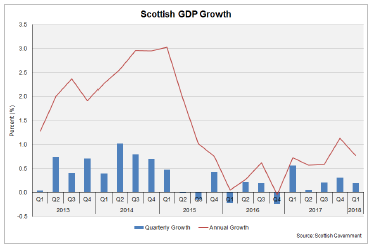
Growth at the start of 2018 was supported by the continuation of moderate growth in the Services sector. In the first quarter of the year, services expanded 0.4% supported by a pick-up in growth in Transport Information & Communication (1.6%) and Professional, Scientific, Administrative & Support Services (1.3%).
The Production sector continued its positive contribution to growth into 2018, with quarterly growth of 0.9% in Q1 2018, unchanged from Q4 2017. Accelerated growth in the manufacturing sub-sector (1.8%) continues to be supported by an improved export environment (stronger international growth and the relatively weak value of Sterling), alongside the gradual strengthening of economic sentiment and activity in the oil and gas sector.
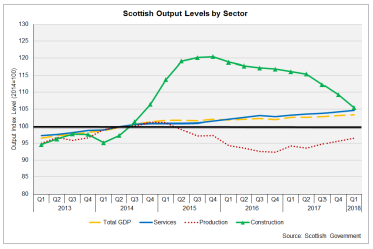
Output growth in the Manufacturing sector was partially offset by contractions in Electricity & Gas Supply and Water Supply & Waste Management – falling by 1.4% and 1.0% respectively – the former having grown 2.4% in 2017, driven in part by record levels of wind-powered electricity generation.
The Construction sector contracted again in Q1 2018, falling by 3.5% - its largest quarterly contraction in the current cycle. The box below explores possible reasons behind the fall in output during the latest quarter.
Looking at longer term trends in the construction sector, the chart on the right disaggregates construction output into its four separate components – housing, infrastructure, other public ( i.e. public sector buildings) and other private ( e.g. industrial and commercial buildings). The series are in nominal terms, not adjusted for inflation, but provide an indication of the underlying drivers of the recent performance in the sector.
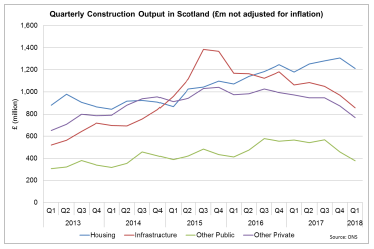
Over the longer term, public sector infrastructure projects have played a key role in boosting construction output, and recently a number of completions on major public sector infrastructure projects - including the Forth Replacement Crossing and M8 'missing link - have led to output falling back. While there is less data on private sector infrastructure projects, examples of major projects over the last few years include the Shetland Gas Plant and Beauly to Denny power line. There has also been sustained growth in wind energy capacity installed in Scotland which has resulted in significant construction activity in Scotland.
House building also remains a strong segment of the industry, in terms of total cash value, with output on an upward trend over a number of years.
Exploring the Recent Contraction in Construction Output
The first quarter of 2018 witnessed a further decline in construction output in Scotland. A similar decline was observed in the UK as a whole. There are several possible explanations for this.
The slowdown in activity at the start of the year was also reflected in other indicators of construction activity in Scotland. For example, building materials data published by the Department for Business, Energy and Industrial Strategy show a drop off in sales of sand and gravel in Scotland in Q1 2018 [1] .
Firstly, construction output exhibits business cycles with relatively higher amplitudes and shorter frequencies than other parts of the economy. Construction has undergone a series of much shorter business cycles which are not so synchronised with the wider economy. As discussed in the last edition of State of the Economy, the sector is currently adjusting back to more normal levels of output following rapid growth in previous years.
A further feature of the industry since the start of the year has been an increase in the number of construction firms going into administration. The collapse of Carillion may have had a limited impact, although the views from Bank of England Agents [2] was that a lot of their work was being picked up by other firms. However, a number of other construction businesses in Scotland have gone into administration over recent months (such as Crummock and Lambert Contracts). Collectively these changes are likely to have reduced activity in the sector.
The severe weather in February and March also caused transport disruption and delays to building projects and will have reduced output. However, any impact from severe weather is likely to be only temporary. The charts show that previous instances of bad weather caused a short sharp fall in construction output which was followed by a rebound in subsequent quarters, essentially deferring output to the next quarter.
Scottish Construction and Severe Weather
Latest business survey evidence [3] on the construction sector reported a fall in sales revenue at the start of 2018, reflecting the contraction in construction in the official statistics. Alongside this there was a decline in public sector new orders, however this was offset by increases in private commercial orders and domestic house building orders. Looking ahead, latest business surveys suggest that business optimism in the construction sector has increased, signalling that businesses expect conditions for the sector to improve over the course of the year.
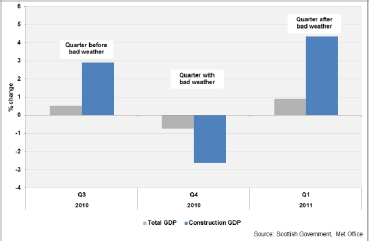
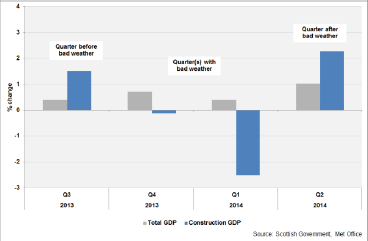
Exports
The strengthening of the global economy in 2017 and the relatively weak value of Sterling have created a more supportive external export environment.
In Q4 2017, the volume of Scottish manufactured exports [4] (excluding offshore oil and gas) increased by 11.3% compared to a year earlier, despite falling by 2.9% over the quarter. Growth over the past year was driven by the Metals & Metal Products, Refined Petroleum, Engineering & Allied Industries and Textiles & Clothing sub-sectors.
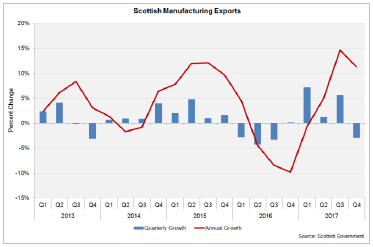
More recent data from HMRC [5] , a separate export survey, show that Scotland's goods exports (including oil and gas) increased in cash terms by £3.1 billion (12%) to £28.8 billion over the year to March 2018, compared to the previous year. This increase was driven by a rise in oil and gas exports to the EU, which increased by £1.7 billion (35%) to £6.7 billion, reflecting in part the rise in energy prices over the past twelve months.
Differences between Scottish and UK International Exports to the EU.
While there are similarities in the composition of exports from Scotland and the UK to the EU, there are also significant differences. Understanding and reflecting these and other differences between UK and Scotland trade are important considerations when assessing the impact of future trade relationships as the UK leaves the EU.
Considering the value of trade with the EU, the adjacent chart [6] shows the ten sectors that account for the greatest share of Scotland's goods exports to the EU. Alongside this are the equivalent share of exports to the EU from the UK as a whole. While there are similarities, exports to the EU from sectors such as beverages (spirits), and fish, crustaceans, molluscs (seafood) are significantly more important to the Scottish economy than they are to the UK as a whole.
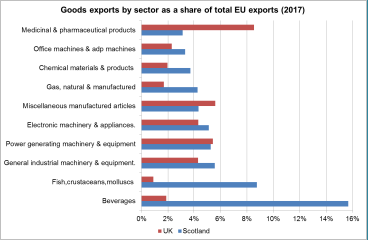
As a more detailed illustrative example of the difference between Scotland and UK trade in the seafood industry, the EU is a key market for Scottish seafood products, accounting for 77% of Scottish seafood exports in 2017. Scotland is a net exporter of fish to the EU and the rest of the world, while the UK as a whole is a net importer.
There are also differences in the export of Services. The adjacent chart [7] shows that for Scotland, professional, scientific & technical and real estate services account for a much larger share of service sector exports to the EU than for Great Britain as a whole. Exports of utility-related services are also more important to Scotland, while information and communication exports are relatively more important to GB as a whole.
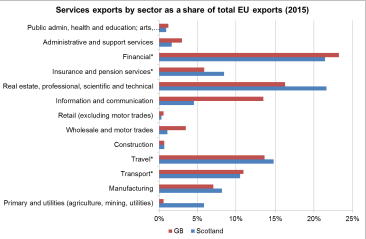
Labour Market
Scotland's labour market tightened in 2017 with the unemployment rate reaching a record low of 3.8% and the employment rate rising to a record high of 75.8% during the year. While easing back slightly from these peaks, the labour market continued to perform strongly at the start of 2018.
Latest data for February to April 2018 shows that the unemployment rate is 4.3%, the economic inactivity rate is 21.4% and the employment rate is 75.2%, all of which are close to record levels.
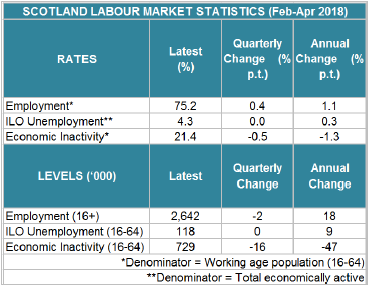
The composition of employment in Scotland has also changed. Since 2016 full-time employment has risen by 56,000 whilst part time employment has fallen by 3,000 as labour market conditions tighten.
Furthermore, latest underemployment data for Scotland shows that the proportion of people in employment looking for additional hours or an additional job has continued its downward trend over the past year decreasing to 8% - its lowest rate since 2008.
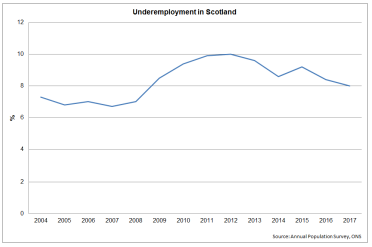
Labour Productivity
Labour productivity (output per hour worked) brings together economic output and labour input and is an important indicator of economic performance.
With output growth below trend in 2017 and the labour market continuing to perform strongly, productivity growth weakened in 2017.
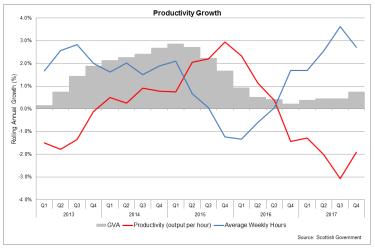
Latest data for Q4 2017 show that on a rolling annual basis, comparing the most recent four quarters to the previous four quarters, labour productivity decreased by 1.9% in real terms.
Despite the contraction in 2017, labour productivity growth continues to be stronger over the longer term, growing 5.4% in Scotland since 2007 compared to FDI average growth of 1.7% over the same period.
Business Sentiment
EY's latest Attractiveness Survey (June 2018), which provides an assessment of global Foreign Direct investment ( FDI) trends showed that in 2017, the Scottish economy had a strong year for attracting FDI projects. It reported that Scotland attracted 116 FDI projects in 2017, in turn securing over 6,300 jobs – the highest in a decade. Over the longer term, the results showed that Scotland has secured more FDI projects than any other region of the UK outside London for five of the past six years.
The report also signalled a shift in the scale of projects coming into Scotland. In 2017, 10 Scottish FDI projects created 200 jobs or more, compared to only 6 projects in 2016 that created 100 jobs or more. The increasing scale of investments into Scotland signal a positive sentiment among foreign investors and the international attractiveness of Scotland's economy.
Scotland's FDI Composition: Sectors and Activities [8]
The latest EY Attractiveness Survey (June 2018) results demonstrate that Scotland's FDI performance remains robust both in terms of attracting investment projects and maintaining its position as the second most attractive location in the UK.
In terms of sectors, in 2017, Scotland's Business Services sector secured the most FDI projects in Scotland (23 projects), accounting for one fifth of all Scottish projects during the year. The Digital sector accounted for the second most projects (14 projects) while the Agri-food sector secured 11 projects, making it the fastest growing sector for projects over the year (up 120%).
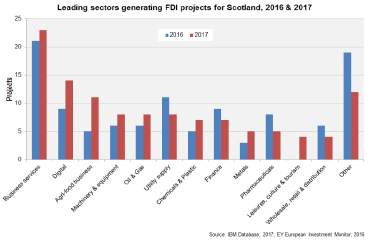
In terms of FDI activities, Sales and Marketing activities made up the highest proportion of FDI projects in Scotland in 2017 accounting for 30% of all Scottish projects. Manufacturing projects' increased by 25% compared to 2016 and with 30 projects, was the second most popular FDI activity in 2017.
2017 also saw 22 Research and Development activity investment projects attracted to Scotland, making it the third biggest activity. This was a 70% increase on 2016 and accounted for nearly a quarter of all UK R&D projects in 2017.
Scottish business surveys [9] have signalled that domestic private sector activity has remained broadly stable into the start of 2018 with the Scotland PMI suggesting that strengthening activity in the Services sector has been supporting more moderate growth in the manufacturing sector.
Looking to the current quarter (Q2 2018), early indications from the RBS Purchasing Managers' Index signal expansion in Scotland's private sector, led by Service providers, with latest results (May 2018) showing growth in employment, new business and business confidence across the sectors.
Across the surveys, the manufacturing and construction sectors have had a softer start to the new year, with firms citing that the bad weather in the first quarter did impact activity. Both sectors reported weaker growth in new orders/contracts over the quarter with the manufacturing sector experiencing a slowing in export order growth, reflecting that the weaker Sterling impacts may have largely passed through, alongside the current uncertainty of overseas demand.
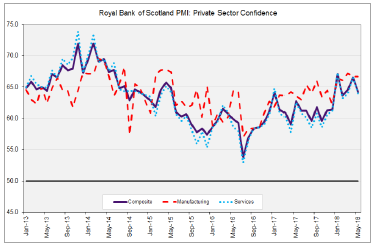
Service sector activity has generally picked up at the start of the year, with the Financial and Business Services sector remaining buoyant, however there are signals that conditions remain challenging for household facing sectors such as retail.
Across all sectors, new order demands are robust enough that job creation and staffing demand continues to be strong to cover both new-orders and back-logs of work. With some sectors reporting recruitment difficulties, this is placing upward pressure on wage settlements. Alongside rising commodity prices, raw material prices and the on-going impacts of weaker Sterling on import prices, continue to be a notable issue for input prices for firms which they continue to pass on, in part, to customers.
Looking ahead, firms expectations of future growth remain positive and business optimism has remained buoyant at the start of the year, with positive expectations for output and employment growth. Despite this, business investment intentions remain weak and fragile, with firms citing uncertainty about future demand and concerns about the potential for returns on investment as key limiting factors.
This is consistent with latest data for Scotland which shows that business investment continued to contract in the final quarter of 2017 which has the potential to weigh on expansionary activity in both the short and longer term.
Consumer Sentiment [10]
Latest data to Q4 2017 shows that while Gross Disposable Household Income has grown by 1.3% in nominal terms over the past year, the savings ratio - an estimate of how much disposable income is put towards savings (or borrowing) - has fallen by 1.7 percentage points.
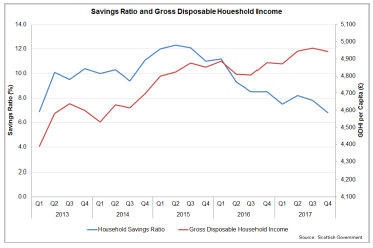
The latest results for Scotland are a continuation of recent trends and in line with the UK as a whole. They indicate that consumer spending is supported, at least in part, by reduced saving and/or new borrowing by households.
The squeeze on household finances is reflected in the Scottish Consumer Sentiment Indicator which remained negative in Q2 2018 and weakened over the quarter from -1.8 to -2.4 ( i.e. more respondents continued to report a decline in sentiment than an increase).
| Scottish Consumer Sentiment |
Latest Score (Q2 2018) |
Previous Score (Q1 2018) |
Change compared to the previous quarter |
|---|---|---|---|
| Overall Indicator Score |
-2.4 |
-1.8 |
-0.5 |
| Economy performance - last 12 months |
-4.0 |
-6.4 |
+2.4 |
| Economy performance - next 12 months |
-10.8 |
-7.5 |
-3.4 |
| Household financial position - last 12 months |
-1.3 |
-1.0 |
-0.2 |
| Household financial position - next 12 months |
6.5 |
9.0 |
-2.5 |
| Attitude to household spending - current |
-2.4 |
-3.3 |
+1.0 |
The latest results show that on balance, more respondents reported that economic performance, household financial position and attitude to spending were weaker than 12-months ago.
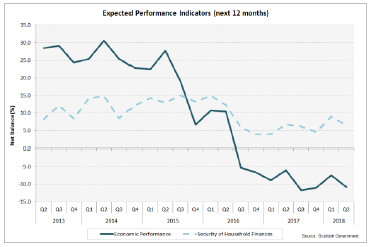
Looking ahead to the next 12-months, the indictors for expected economic performance and expected household financial position decreased over the quarter signalling a weakening in sentiment. However, on balance, more respondents continue to expect their household financial position to improve, despite more respondents expecting overall economic performance to weaken.
The mixed picture in economic sentiment is reflected in the Scottish Retail Sales Index for Q1 2018. Growth in the volume of retail sales in Scotland picked-up in the first quarter of the year to 0.5%, following a slight contraction at the end of 2017, with growth holding steady at 1.5% compared to Q1 2017. However, the pace of retail sales growth remains subdued relative to 2016 in Scotland and GB as a whole.
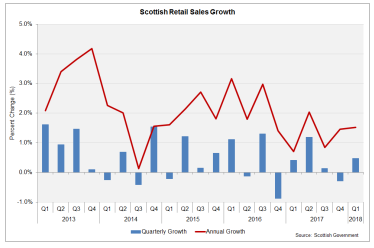
Scottish Economic Outlook
The outlook for the Scottish economy remains similar to the picture at the start of 2018 with independent forecasters suggesting growth will quicken over the forecast horizon but will remain below Scotland's long run trend growth rate of just below 2%.
However, there is variation among independent forecasts for Scotland. For example, in 2018 the forecast for growth varies between 0.7% and 1.3% and in 2019, it varies between 0.8% and 1.6%.
| Independent Scottish GDP Growth Forecasts (%) |
|||||||
|---|---|---|---|---|---|---|---|
| 2017 (outturn) |
2018 |
2019 |
2020 |
2021 |
2022 |
2023 |
|
| Scottish Fiscal Commission |
0.8 |
0.7 |
0.8 |
0.9 |
0.9 |
0.9 |
0.9 |
| Fraser of Allander Institute |
1.2 |
1.3 |
1.3 |
- |
- |
- |
|
| EY ITEM Club |
1.3 |
1.6 |
1.5 |
1.7 |
- |
- |
|
| PWC |
1.0 |
1.2 |
- |
- |
- |
- |
|
Independent forecasters point to a number of drivers for this subdued level of growth over the forecast horizon. A key factor influencing the medium-term outlook continues to be the expectation of weak productivity growth, and its downward pressure on wage growth.
Wage growth forecasts remain relatively weak for Scotland, despite high employment and low unemployment by historical standards. With inflation forecast to fall over the course of this year and next, there is the potential for the squeeze on real wage growth and household finances to ease.
The strengthening in global economic activity alongside the relatively low value of Sterling should continue to provide a stronger backdrop for export and investment activity, while the strengthening of sentiment and activity in the oil and gas sector should also be more supporting of growth.
However, independent forecasts continue to expect the uncertainty from Brexit to weigh on business investment decisions and consequently on economic growth.
Contact
There is a problem
Thanks for your feedback